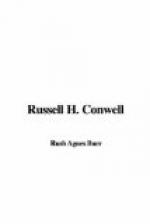But as this man looked into the brook, he leaped off that ash barrel and managed to catch the trout with his fingers, and sent it to Worcester. They wrote back that they would give him a five dollar bill for another such trout as that, not that it was worth that much, but he wished to help the poor man. So this shoemaker and his wife, now perfectly united, that five dollar bill in prospect went out to get another trout They went up the stream to its source and down to the brimming river, but not another trout could they find in the whole stream; and so they came home disconsolate and went to the minister. The minister didn’t know how trout grew, but he pointed the way. Said he, “Get Seth Green’s book, and that will give you the information you want.” They did so, and found all about the culture of trout. They found that a trout lays thirty-six hundred eggs every year and every trout gains a quarter of a pound every year, so that in four years a little trout will furnish four tons per annum to sell to the market at fifty cents a pound. When they found that, they said they didn’t believe any such story as that, but if they could get five dollars a piece they could make something. And right in that same back yard with the coal sifter up stream and window screen down the stream, they began the culture of trout. They afterwards moved to the Hudson, and since then he has become the authority in the United States upon the raising of fish, and he has been next to the highest on the United States Fish Commission in Washington. My lesson is that man’s wealth was out there in his back yard for twenty years, but he didn’t see it until his wife drove him out with a mop stick.
I remember meeting personally a poor carpenter of Hingham, Massachusetts, who was out of work and in poverty. His wife also drove him out of doors. He sat down on the shore and whittled a soaked shingle into a wooden chain. His children quarreled over it in the evening, and while he was whittling a second one, a neighbor came along and said, “Why don’t you whittle toys if you can carve like that?” He said, “I don’t know what to make!” There is the whole thing. His neighbor said to him: “Why don’t you ask your own children?” Said he, “What is the use of doing that? My children are different from other people’s children.” I used to see people like that when I taught school. The next morning when his boy came down the stairway, he said, “Sam, what do you want for a toy?” “I want a wheel-barrow.” When his little girl came down he asked her what she wanted, and she said, “I want a little doll’s washstand, a little doll’s carriage, a little doll’s umbrella,” and went on with a whole lot of things that would have taken his lifetime to supply. He consulted his own children right there in his own house and began to whittle out toys to please them. He began with his jack-knife, and made those unpainted Hingham toys. He is the richest man in the entire New England States, if Mr. Lawson is to be trusted in his statement concerning such things, and yet that man’s fortune was made by consulting his own children in his own house. You don’t need to go out of your own house to find out what to invent or what to make. I always talk too long on this subject.




